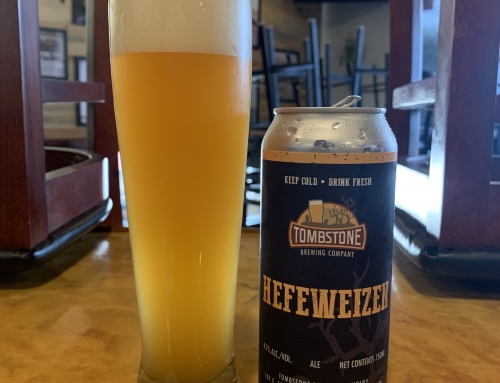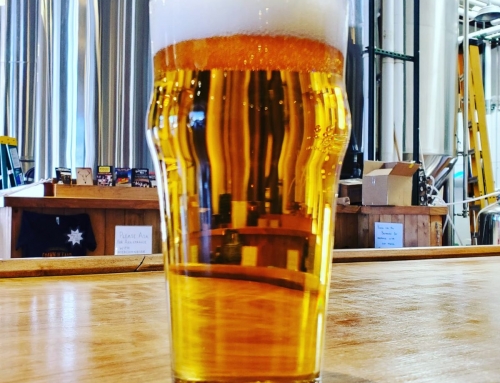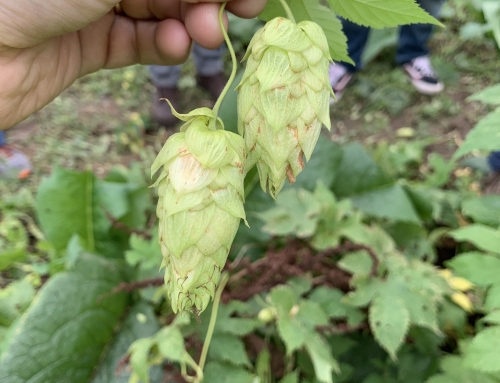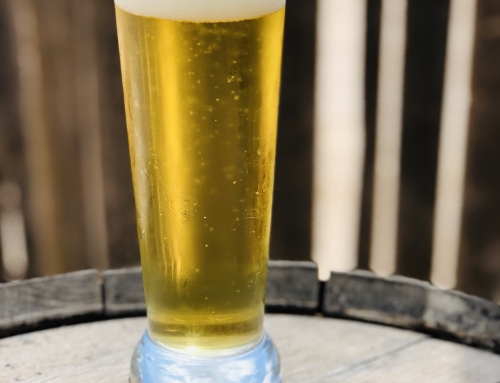As I sit down to type up this post, it strikes me that this is a pretty comical way of eating my words. Not only am I excited about using new techniques that I had written off and even mocked a little bit, but I’m also announcing the release of a style that I’ve called dumb on many occasions in the last year.
In the 6 years since I graduated from the World Brewing Academy, any time someone asked me about removing oxygen from the hot side of a brewery (meaning eliminating oxygen in the mash, lauter, and boil) I told them the story about how one of our professors at Doemens in Munich had conducted a study where they injected pure oxygen into every step of the brewing process up until they pitched yeast. They brewed the same beer side by side with another batch that used their normal techniques. They determined that each beer in the end tasted the same. I took them at their word, didn’t question the study (after all, the study was conducted at a prestigious German brewing school with far more knowledgeable chemists and biologists than myself), and told anyone that asked me about the topic of this study and pointed out that many world class beers don’t use those techniques.
At the time that I was in school talking with this professor, I was also reading the textbook that the World Brewing Academy curriculum was based off. In the textbook, on numerous occasions, the author mentions the detrimental effects of oxygen at any stage of the brewing process. I asked the professor about that and I was told that they disagreed based off their study.
6 years later after sharing this story on numerous occasions, I found myself questioning their study. It all started as I decided that I wanted to transition Tombstone lagers to 100% natural carbonation in an effort to create a mouthfeel that is more crisp than the lagers I’ve been brewing for almost 10 years now. One of the problems with attempting all natural carbonation is that the temperature at which the full carbonation level that we target can be achieved is right around 42 degrees F. If the beer is warmer than that, the pressure of the vessel holding the beer needs to be above 15 psi which is what almost every vessel used in the USA is rated for. So to keep the brewery safe and achieve natural carbonation, I needed to get the temperature of the fermenters lower, but also keep the yeast from going dormant and not fermenting or creating off flavors.
I pulled out my textbook and was going to flip to the pages that detail various types of fermentation methods for lagers when it landed open on a page that was all about oxidation in the mash tun. I laughed to myself been discussing the silliness of the extremes that some homebrewers were going to to eliminate hot side oxygen. But then it got me thinking again…
One of the most interesting things to me about brewing is that every step of the brewing process can (and does) happen naturally without human interference. As a brewer, we’re really facilitating reactions and manipulating a natural product to create the product we want. All of the enzymes, nutrients, and naturally occurring preservatives are all present in the ingredients that are required for making high quality beer. Barley’s husk and ability to crush the barley without destroying the husk material is even the perfect filtration aid for a mash/lauter. All a brewer has to do is facilitate the necessary enzymatic reactions to start brewing a beer, but when we use a conventional process that includes oxygen in the hot side, we actually destroy some of the natural preservatives such as ascorbic acid, polyphenols, and tannins.
As I thought about that, I recalled a conversation with a mobile canning operation from a few years ago. They were trying to figure out why they had inconsistent oxygen pickup occurring in their canning line. They determined that if they showed up at a brewery and they tested a beer with less than 10 parts per billion (ppb) total oxygen in solution, their canning line would introduce less than 50 ppb. But if they showed up and the beer had 20 ppb, rather than picking up 50 ppb in the canning line, they might pick up as high as 200 ppb. No matter what school of thought you subscribe to with hot side oxygen, everyone agrees that oxygen in packaged beer is one of the biggest enemies to shelf life and flavor stability and the general industry standard is to have packaged beer with less than 50 ppb introduced at the time of packaging. My theory at the time was that the elevated oxygen pickup before packaging was interacting with proteins and resulting in poor foam formation which in turned allow more oxygen pickup in a canning line.
I started to wonder if there was any relation to hot side oxygen with their results. At face value, it doesn’t make sense because boiling removes oxygen from wort anyways, so no oxygen will exist in wort after a boil no matter how much oxygen gets introduced before. However, what does change is the amount of natural preservatives that make it into the kettle if oxygen is introduced in the mash. But the factor that I didn’t consider originally was that when beer ferments, yeast produces sulfur. Sulfur is a natural anti oxidant and is also very volatile. When sulfur interacts with oxygen, it will reduce the oxygen and the sulfur will dissipate. If too much oxygen is introduced in a beer transfer, then the sulfur would be used up and then there’s no sulfur to help protect the beer when it gets canned. The only remaining preservatives in the beer would then be ascorbic acid, polyphenols, and tannins. None of them are as effective at reducing oxygen as sulfur is and if you’ve already used those up by introducing oxygen in the mash tun, then there would be very little left to protect the beer in packaged form.
Even though we’ve always had very low oxygen in our packaged beer and a relatively good shelf life, I started to wonder if our techniques could be improved even further. Our brewhouse isn’t really set up for low oxygen brewing, but I found a few ways to work around that. Starting in June, all of our beers have been brewed with low oxygen techniques that include completely deaerating our brewing water and purging all the water in-line with co2 to prevent oxygen pickup that might come from a pump or from splashing. As a result, we’ve been able to reduce our dissolved oxygen in our mash tun from about 4 parts per million (ppm) down to about 100 parts per billion.
The results of the shelf life haven’t actually been that surprising… The beers we’ve brewed this way taste fresher for longer. It makes perfect sense because we have been able to carry natural preservatives from the grain all the way through to the canned beer. What has been surprising though is the positive impacts that have occurred with head retention, color, and flavor. When we brewed the first batch, it was immediately clear that there was a difference in the wort composition. Instead of tasting grainy or astringent, the wort tasted bright and distinctively barley-like. It was obvious that we had preserved the nuanced flavor of the barley itself. When we started transferring the wort to the kettle, instead of looking lightly hazy, the wort looked like crystal clear, filtered beer. When we poured samples from the tank, the foam looked dense. But perhaps most surprisingly, the beers tasted “brighter” with a more obvious development of flavor in each sip. It’s not like an entirely new flavor profile, but rather a more refined version of the same flavors. It’s similar to when we all watched DVD’s and thought the quality was awesome, but then we saw Blu-Ray for the first time… We went from tasting in standard definition to high definition.
As for why my results are different from the results shared by a professor at Doemens… I kept on doubting that what we were doing would make any difference, but after going through this process and experiencing it firsthand, I think the key difference is that at Doemens they injected pure oxygen in one batch and they brewed another batch with their normal techniques… They didn’t actually eliminate oxygen and compare side by side with a beer brewed with excess oxygen. Oxygen saturation is largely temperature dependent, so even if they were injecting pure oxygen, they wouldn’t have been able to get it to dissolve any more in the hot liquid than what they already had in their normal brewing process.
While we have released several IPA’s brewed this way, the differences are much more noticeable in lagers since the flavors are more subtle. The first lagers that we brewed this way are scheduled to be canned on Monday next week and they include 2 Pilseners and our Festbier.
The first Pils getting canned is the style that I have joked about being a dumb style… Italian Pils. When I first started hearing people talk about this “new style” of Pils a couple years ago, I asked what made it different from other styles of Pilseners. The answer I was given was that Italian Pils is like a German Pils (The main example that people point to as the originator of the style is even brewed with all German ingredients and was an attempt at recreating a German Pils) but it’s dry hopped. If that’s the case, it’s still just a German style Pils. The confusion stems from Germany’s beer purity law which previously stated that hop extracts or powders weren’t permitted to be added at any point after the boil was complete. Many people believed this meant that dry hopping wasn’t permitted and in 2012 the law was updated to clarify that dry hopping with natural hops was allowed, but concentrates, extracts, and powders are still prohibited. However, dry hopping with whole hops was never illegal and has in fact been taught at Weihenstephan since at least 1907. Furthermore, the brewery that “invented” this style opened in 1995. In America, there was breweries brewing all malt Pilsners that were dry hopped with German hops before prohibition, so it’s not like the style was invented in Italy. On top of all that, one brewery brewing a different style in a country doesn’t make a style that gets a regional designation like that.
All that said, I actually love dry hopped Pilseners, so I’m happy to see the style taking off, I just wish we didn’t feel the need to label something differently as an industry. Because of that, we decided to brew an “Italian Pils” that couldn’t be confused with a German Pilsener. We used malt that was malted from barley grown just North of Venice by the Adriatic Sea. It’s known for it’s slight honey like flavor with great foam stability. Instead of German hops we opted to use French Strisselspalt in the kettle and a new French hop, Barbe Rouge, which gives some lemony citrus aroma as well as a slight black currant flavor. This is perhaps the most crisp and refreshing Pils to come out of Tombstone.
Our Festbier saw another minor change this year in addition to the low oxygen brewing. In an attempt to recreate a “more German” flavor profile, we opted to acidify our mash with sour wort rather than our normal lactic acid acidification. In Germany, lactic acid in the mash is prohibited so brewers use sour wort or barley sprayed with sour wort to make pH adjustments. Sour wort is naturally acidified with bacteria which creates far more flavor than the one dimensional flavor profile that you get from 88% pure lactic acid. This enhanced depth of flavor along with the low oxygen brewing makes this year’s Festbier taste far more similar to the beers I remember drinking in Germany.
The 3rd lager we’re about to release is a Sub-Saharan West African Pils. It’s brewed in a completely authentic Sub-Saharan West African Pils tradition and is definitely not a style that is entirely made up by some brewers in Tombstone with too much time on their hands.






Leave A Comment